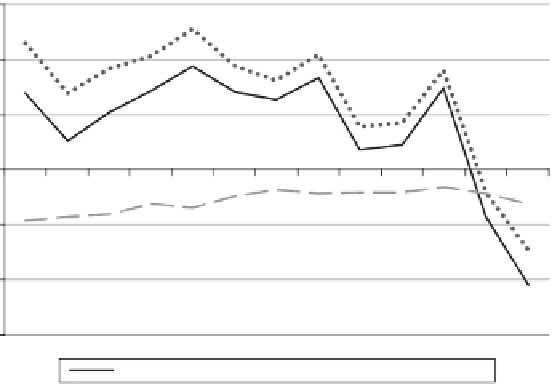Environmental Engineering Reference
In-Depth Information
Japan, relegating it to third position. Industrial competitiveness is deteri-
orating. South Korean, Taiwanese, and Chinese irms have begun to chal-
lenge Japanese leadership in technology sectors that have been traditionally
dominated by Japanese irms such as Sony, Toshiba, Panasonic, Toyota and
Honda. Unemployment, which ranged between 2 to 3% during the eco-
nomic heydays of the 1980s, now hovers between 4 to 5%; as of 2010, 16%
of the population was living below the poverty line.
58
Although adequately assessing the economic health of a given nation requires
a level of analysis that is beyond the scope of this chapter, Figure 9.8 highlights
an inluential and troublesome trend. National aluence has grown, thanks to
years of trade surplus. Between 2000 and 2010 Japan's trade balance plateaued,
despite a 75% increase in global GDP. his suggests that the nation's industries
have been challenged in overseas markets, and aluent Japanese citizens have
been purchasing increasingly higher volumes of imported goods. In 2011, for the
irst time since 1980, Japan posted an annual trade deicit, a development that
can be thought of as a transfer of wealth from domestic parties to other nations.
Although this trade deicit was caused primarily by elevated natural gas imports
following the Fukushima disaster, it is a trend that cannot be allowed to continue
if the nation wishes to maintain industrial competitiveness.
he greatest economic concern is that Japanese industry now faces intense
international competition. Mechanization has cascaded downward to other
emerging economies, allowing nations such as South Korea, Taiwan, and
even China to successfully compete head-on with Japan. Moreover, inter-
national pressure during the 1990s forced Japan to liberalize its domestic
150,000
100,000
50,000
0
-50,000
-100,000
-150,000
Total Trade Balance
Goods
Services
Figure 9.8
. Japan's Annual Trade Balance 2000-2012
Source of data
: Balance of Payments Statistics (Ministry of Finance and Bank of Japan), 2013.


